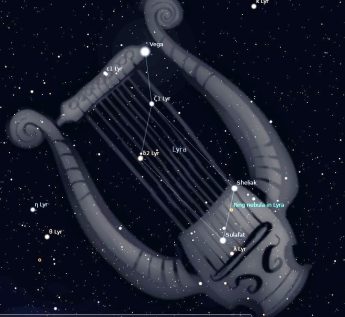This Week’s Sky at a Glance, 2025 May 24 – May 31
This Week’s Sky at a Glance, 2025 May 24 – May 31
With turkey vultures becoming more prominent in the province you might be interested in knowing a vulture once flew with the swan and the eagle in the sky. The bright star Vega can be seen high in the east in the late evening. Vega’s constellation is Lyra the Lyre or Harp, with the main part of the instrument being formed by a parallelogram of stars. If you point a telescope between the two brighter stars of the parallelogram, opposite Vega, you might notice a fat, blurry star. A moderate-sized telescope will show it as a smoke ring or doughnut. This is the Ring Nebula or M57, the remnants of a Sun-sized star that puffed off its layers of gas when it ran out of nuclear fuel. Near Vega is a dimmer but naked-eye star that binoculars will show as two stars, and a telescope at high power will reveal each of those as double stars. This star, Epsilon Lyrae, is nicknamed the Double-Double, so with a coffee and a doughnut I regard Lyra as the Tim Hortons constellation.
In mythology the lyre was made from a tortoise shell by the god Hermes, who gave it to Apollo. It was mastered by Apollo’s son Orpheus, who soothed all around him when he played. After his bride was killed tragically on their wedding night, he spurned the advances of the many young ladies vying for his attention. They schemed revenge, screaming loudly so as not to be affected by his music, and then beat him to death and tossed the lyre into the river. In one version of mythology, Zeus sent a vulture to retrieve the lyre and had it placed in the sky to commemorate Orpheus and his music. Star maps from a few centuries ago depicted the lyre in the talons of the vulture.
This Week in the Solar System
Saturday’s sunrise in Moncton is at 5:37 and sunset will occur at 8:55, giving 15 hours, 18 minutes of daylight (5:45 and 8:57 in Saint John). Next Saturday the Sun will rise at 5:32 and set at 9:02, giving 15 hours, 30 minutes of daylight (5:40 and 9:04 in Saint John).
The Moon is new on Monday and it slides up and over Jupiter between Tuesday and Wednesday, and then it approaches Mars next Saturday. Mars crosses the constellation border into Leo the Lion this weekend. Venus rises to the right of the waning crescent Moon around 4 am this Saturday, with Saturn to their upper right. Neptune can be seen half a binocular field to the left of Saturn, with a brighter star just above. The two planets will share a binocular view for the rest of the year. Mercury is at superior conjunction on May 30, appearing in the evening sky in mid-June.
The Spring Star Party at Kouchibouguac National Park takes place next Friday and Saturday. See the rascnb website for details. Tune in to the Sunday Night Astronomy Show at 8 pm on the YouTube channel and Facebook page of Astronomy by the Bay.

